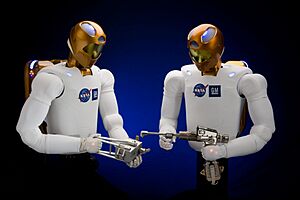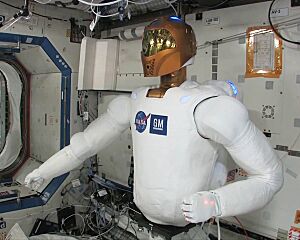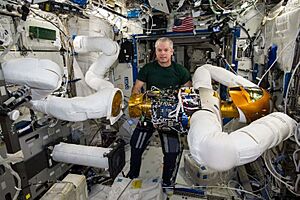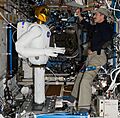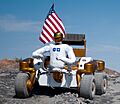Robonaut facts for kids
A Robonaut is a special type of humanoid robot. It was created by NASA at the Lyndon B. Johnson Space Center in Houston, Texas. Unlike other space robots that move big things, Robonauts are designed for tasks needing careful, skilled movements.
The main goal of the Robonaut project is to build robots that can work side-by-side with astronauts. These robots are made to be very similar to humans in shape and movement. This way, they can do many of the same jobs an astronaut would do during a spacewalk.
NASA believes Robonauts are very important for future space missions. Especially as humans plan to travel beyond low Earth orbit. The Robonaut 2 (R2) helps NASA learn how robots and astronauts can work together in space.
The newest Robonaut, called R2, arrived at the International Space Station (ISS) in February 2011. It was sent there on the STS-133 mission. R2 was the first American-built robot to live on the ISS. It is a robot torso, meaning it has a body and arms but no legs. It helps astronauts with tasks and can even hold their tools.
However, R2 was not built to work outside the space station. It would need special upgrades to handle the harsh conditions of space. It also needs changes to move around inside the station on its own. As of 2018[update] NASA had plans to bring R2 back to Earth for repairs. They hoped to send it back to space later.
Contents
Robonaut 1: The First Steps
Robonaut 1 (R1) was the very first model of this robot. There were two main versions, R1A and R1B. Many groups, including DARPA, helped build them. These early Robonauts did not go into space.
Scientists thought R1 could be used for teleoperation. This means a human could control the robot from far away. For example, astronauts orbiting a planet could guide R1 on the surface. This would let the robot explore dangerous places.
R1 could be attached to different bases. One was the "Zero-G Leg." This leg would help R1 move around the space station. It could grab onto handrails and special sockets. Another base was the "Robotic Mobility Platform" (RMP). This was a two-wheeled base, like a Segway PT, made in 2003. In 2006, a four-wheeled base called Centaur 1 was also developed.
R1 even took part in tests in the Arizona desert. These tests helped NASA learn how robots could work in tough environments.
In 2006, the car company General Motors became interested in Robonauts. They decided to work with NASA. In 2007, they signed an agreement to develop the next Robonaut together.
Robonaut 2: A New Generation
In February 2010, the world met Robonaut 2 (R2). This new version was much faster than R1. It was also smaller, more skilled, and had better sensors. R2's arms can move up to 2 meters per second. It can lift about 18 kilograms (40 pounds). Each finger can grip with a force of about 2.3 kilograms (5 pounds). R2 has over 350 sensors and 38 powerful PowerPC computer chips.
R2's Amazing Features
Astronauts on the ISS can control R2. People on Earth can also control it using telepresence. This means they can operate it from a distance. A big improvement in R2 is that it does not need constant watching. It can be given a job and then do it on its own. It only needs occasional check-ins.
R2's hands are very advanced. They have 12 ways to move, like a human hand. Its wrist can also move in 2 ways. R2 even has touch sensors on its fingertips. This helps it feel what it is touching.
R2 was first built to be tested on Earth. But NASA managers were so impressed they decided to send it to the ISS. They made many upgrades for space. For example, its outer skin was changed to be fire-safe. Extra shielding was added to protect it from electronic interference. Its computer chips were made stronger against space radiation. The fans were replaced with quieter ones. And its power system was changed to work with the station's electricity.
To help R2 "see," it uses special cameras. It has a 3D camera and a pair of stereo cameras. These cameras give R2 information about depth and visible images. This helps the robot understand its surroundings. Special software helps R2 process all this visual information.
R2's Journey to Space
Robonaut 2 launched into space on February 24, 2011. It traveled to the ISS aboard the STS-133 mission. On August 22, R2 was turned on for the first time in space. This was a test of its power system. On October 13, R2 made its first movements in space.
The space station is a perfect place to test robots. It shows how they can work closely with humans in microgravity. If R2 works well inside the station, it could get more upgrades. It might get legs and new software. This would let it move around the station. It could even do jobs like cleaning.
A pair of legs for R2 arrived at the ISS in April 2014. They were sent on the SpX-3 mission. A battery backpack was also planned to be sent later. With more upgrades, R2 could even work outside the station. It could help astronauts with spacewalks. It might help with repairs or experiments.
Future Plans for R2
On April 1, 2018, NASA announced that R2 would return to Earth. It came back in May 2018 on the CRS-14 Dragon spacecraft. The plan was to repair R2 and send it back to space later. As of 2018[update] NASA hoped to relaunch it in about a year.
However, as of 2024, R2 has not returned to space. It is now on display for everyone to see. You can find it at the Steven F. Udvar-Hazy Center. This is part of the National Air and Space Museum in Virginia.
Learning from R2's time on the space station is very important. This experience helps NASA understand what robots can do. This knowledge will be useful for future missions. Especially for long journeys into deep space.
Project M: R2's Lunar Dreams
In late 2009, NASA's Lyndon B. Johnson Space Center talked about a new idea. It was called Project M. If this project had been approved, it aimed to land an R2 robot on the Moon. The goal was to do this within 1,000 days.
See Also


